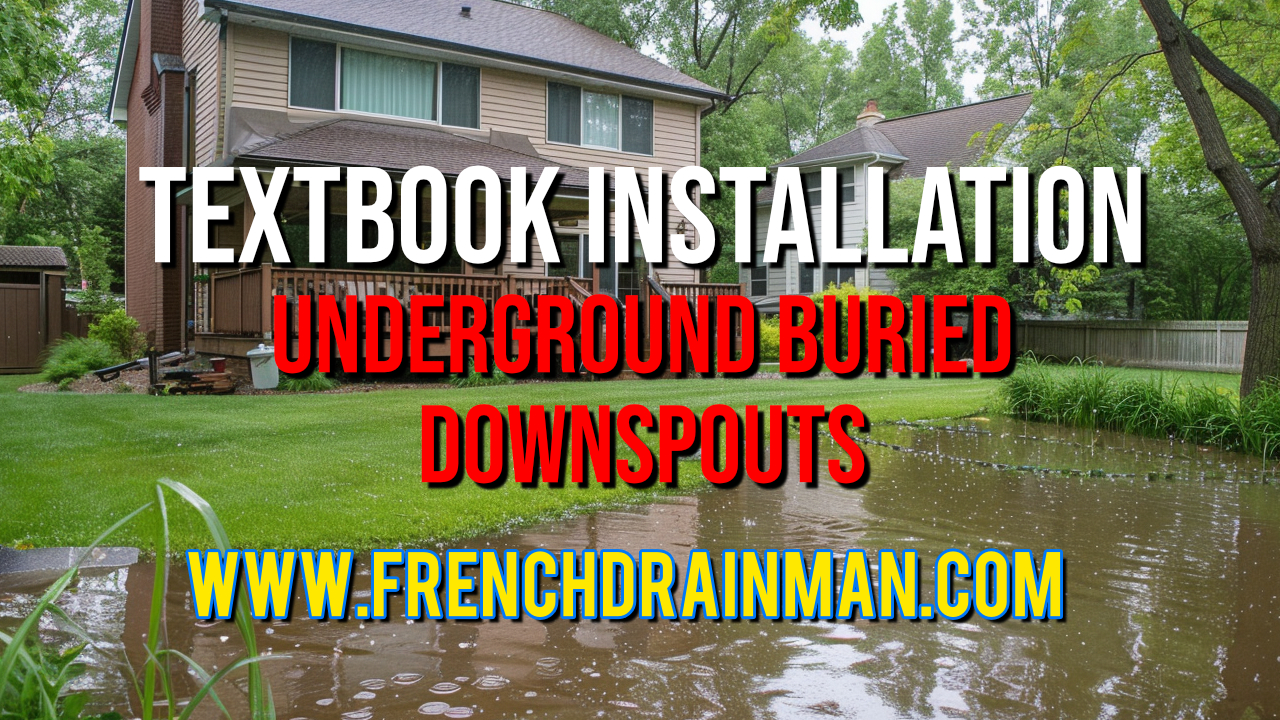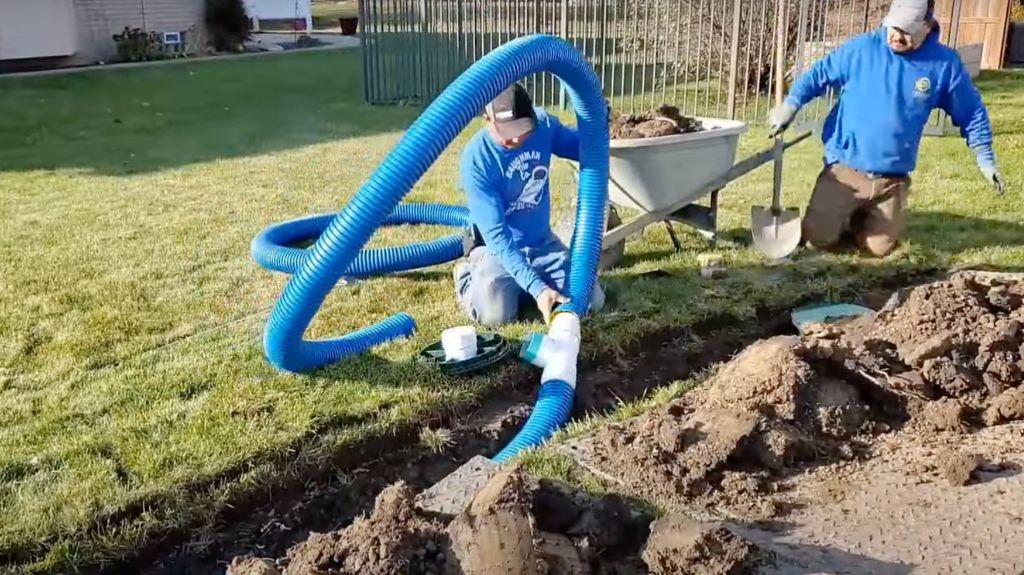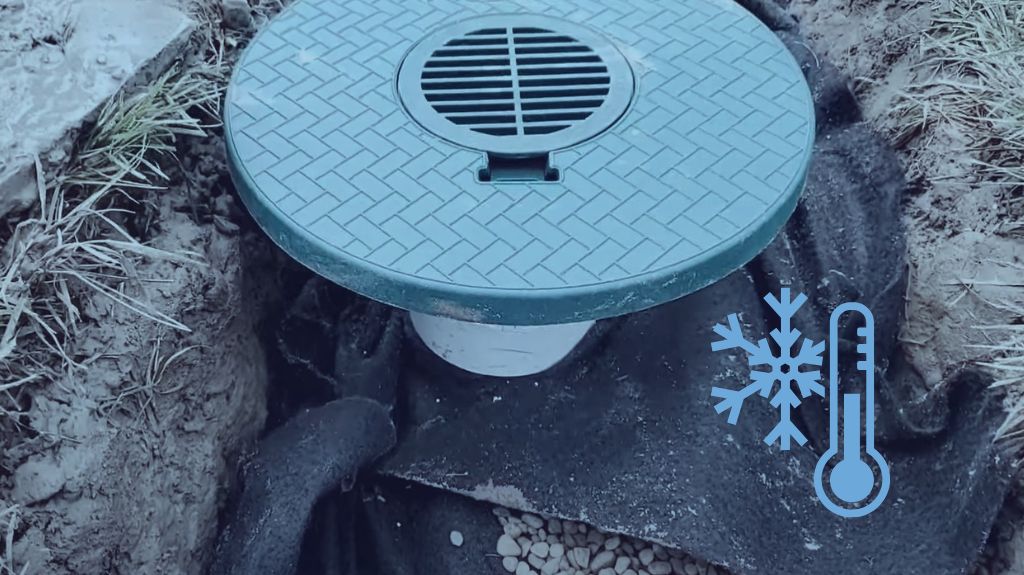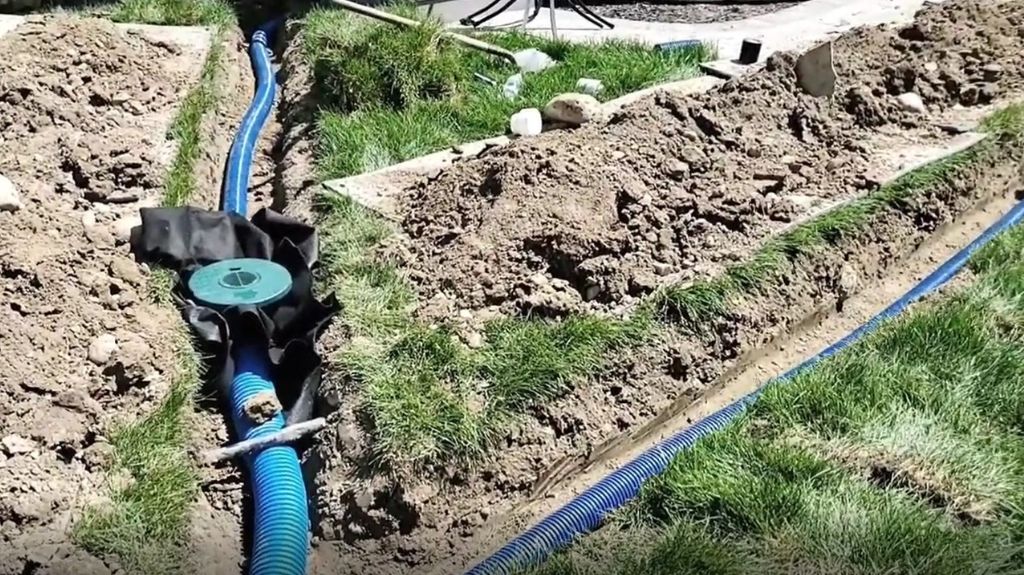Underground Buried Downspouts
Are you experiencing persistent puddles or waterlogged areas in your yard every time it rains? One solution could lie beneath the surface: the installation of underground buried downspouts. These systems are designed to manage roof runoff and strategically redirect it, protecting foundations from moisture damage while improving landscape health. This comprehensive guide will explore all the essential steps in installing underground buried downspouts, equipping you with the knowledge to tackle or understand this vital home improvement project.
Water movement around your property is paramount, as improper drainage leads to foundation seepage, soggy lawns, and potentially severe structural damage over time. Underground downspouts offer an elegant solution by discreetly channeling rainwater away from your home while working seamlessly with gutter systems to maintain dry yards and ensure rainwater runs off efficiently – helping keep them healthy!
Furthermore, these systems help solve common drainage problems experienced by many homeowners across different regions – from heavy clay soils that impede water flow to sandy soils that lack sufficient moisture retention. By the time this article ends, you’ll have an in-depth knowledge of how underground downspouts work, why they are essential parts of any effective drainage plan, and how best they can be implemented into a home’s design to maximize their effectiveness.
Join us as we examine each step of the installation process, discuss required tools and materials, and provide expert tips to ensure your underground drainage system’s success. Whether you are DIY-minded or seeking professional guidance, this guide offers all of the insights necessary for making informed decisions regarding managing yard drainage efficiently.
Importance of High Starting Points
Installation of underground buried downspouts requires careful consideration when choosing their starting point. Elevation is one key component in their efficiency, and using specific fittings is instrumental to their effectiveness. This section explains why downspout placement plays such an integral role.
Utilizing Initial Elevation to Achieve Effective Slope
Starting the downspout at a higher elevation requires more than simply connecting it to gutters; it involves setting the stage for optimal water flow from day one. A gentle yet effective slope is quickly established by attaching a 12″ extension and the French Drain Man’s “not quite 90” fitting at the start. This helps channel debris, such as shingle gravel, smoothly toward your catch basin and decreases the risk of clogs or backups.
Effective Water distribution to catch basins
Positioning an inline catch basin three feet below where the downspout begins takes advantage of the natural slope created by the initial setup to quickly collect any shingle gravel carried by runoff and ensure it lands in the catch basin rather than building up inside your pipe system. Not only does this reduce obstruction risk in underground systems, but it also simplifies maintenance by centralizing debris collection for easier access and removal.
Protect Your Foundation Now
An appropriately sloped and well-positioned downspout is critical to avoiding foundation problems. By making sure it starts high and immediately slopes away from your home, water can be efficiently diverted away from its path toward the foundation, decreasing the risk of basement seepage or structural damage and saving on repairs in areas with clay soil, which tends to be less forgiving regarding diversion efforts.
Ensuring Longevity and Efficiency
Integrating French Drain Man’s custom fittings, such as “not quite 90,” into downspout installation not only improves flow and drainage efficiency but also increases the longevity and efficiency of the drainage system. These fittings provide optimal angles to maximize drainage while minimizing wear-and-tear stress on system components.
As mentioned previously, initial height and slope in underground buried downspout installations are more than mere technical considerations; they’re vital to creating an effective water drainage system for your home. By paying careful attention to these details, you can ensure a robust solution that protects against potential water damage to your property.
Detailed Walkthrough of the Installation Process
Installing underground buried downspouts requires careful consideration to ensure efficient drainage and the longevity of your system. Below is a step-by-step guide on installing these downspouts correctly, including how copper sulfate can prevent root intrusion.
Step 1: Planning and Layout
Before beginning digging, carefully plan the route from your downspout on your home to its discharge point, which should be outside the foundation and in an area capable of managing extra moisture. Make sure the path has an even downward slope that promotes water flow.
Step 2: Digging the Trench
Dig a trench along your planned route using a shovel. Ensure the depth and width support 3″ solid pipe attached to the “not quite 90” fittings. Depending on local conditions and your property requirements, 12-18 inches should suffice.
Step 3: Laying the Pipe
While installing the downspout adapter at your gutter’s downspout and connecting the 12-inch extension pipe, attach a French Drain Man “not quite 90″ fitting to immediately create an immediate slope. Continue laying solid 3” corrugated pipe along the trench, slightly downward towards the catch basin, and check with a level to ensure the slope angle meets drainage needs.
Step 4: Assess Root Invasion Issues
Copper sulfate is a deterrent that pushes roots away from the pipe, protecting its integrity while ensuring proper drainage systems. To do so, pour it along its entire length in trenches around its corrugations before covering it with soil or gravel. It should do its job effectively while simultaneously helping ensure drainage systems run efficiently.
Step 5: Installing the Catch Basin
Install the catch basin approximately three feet from your home’s foundation, ensuring it sits firmly atop a corrugated pipe and at an appropriate depth below the pipe’s level for optimal debris collection and easy cleaning.
Step 6: Filling and Restoration
Once all components have been carefully installed, backfill the trench with dirt up to several inches below its surface and finish off by covering it with sod for your landscape needs.
Step 7: Validation of the System
Once installed, it is essential to test your system by running water through the downspout and watching where it flows toward the catch basin. Watch for areas where pooled or nondraining areas exist and make adjustments as necessary.
Step 8: Final Touches and Maintenance Tips
Make sure the area surrounding and along the trench is landscaped to match your yard’s theme and check and clean the catch basin often to prevent debris build-up.
By following these detailed steps, you can ensure your underground buried downspout system is installed correctly and functions efficiently. With proper precautions, such as using copper sulfate for root control, your system should serve you for years, keeping foundations safe while clearing yards free from standing water.
Maintenance Tips
Proper maintenance of an underground downspout system is vital to ensure its continued efficient and effective functioning over the years. Regular upkeep can prevent issues like clogs, backups, system breakdowns, and water damage to your property from developing over time. Here are some essential maintenance tips to ensure its top condition:
Regular Inspections
Schedule regular checks of your drainage system, especially after heavy rainfalls or significant weather shifts. Be on the lookout for signs of sediment build-up, water pooling, pipe damage, or catch basin issues, which can save money and effort in future repairs. Early detection can prevent more extensive and expensive repairs.
Cleaning Catch Basins
Over time, catch basins become home to debris such as leaves, shingle gravel, and dirt that, if left accumulated for too long, obstruct water flow. This simple task can become invaluable in increasing drainage system effectiveness.
Checking and Clearing Pipes
Make sure that the underground pipes are free from obstruction. A garden hose may help flush away minor blockages; for more stubborn blockages.
Manage Tree Roots
If your property features large trees, their root growth can pose a problem for buried downspouts. Installing copper sulfate helps deter root intrusion; however, it should be applied periodically along the pipe route to maintain its effectiveness.
Visual Inspections for Erosion
Regular visual inspections around discharge points and trench lines should be conducted for signs of erosion or settlement. If soil erosion or landscape settling is observed, more soil or gravel may need to be added to stabilize the area and ensure water runs off as intended.
Professional Assessments
If your DIY maintenance efforts don’t seem to help resolve problems or don’t provide satisfactory solutions, it may be time for professional assessments. A drainage expert can offer an in-depth evaluation and address any underlying issues that might not be apparent at first glance.
Adherence to these maintenance tips will significantly extend the life and functionality of your underground downspout system, ensure its protection from water-related damages, and keep your yard beautiful and functional, no matter the weather conditions.
Root Deterrence
Root intrusion can be one of the biggest challenges to maintaining an efficient underground drainage system. It can lead to blockages and damage that threaten to compromise its functionality. Here, we explore practical strategies for root deterrence so your underground downspouts remain clear and fully operational.
Understanding Root Behavior
Roots seek moisture sources through tiny openings in your drainage system, taking advantage of any weaknesses to invade and take hold. Once inside, they can expand and restrict water flow or break pipes, leading to costly repairs; understanding this behavior is crucial in creating strategies to prevent intrusion.
Copper Sulfate as a Drainage Barrier
Copper sulfate is an increasingly popular solution for controlling root growth in drainage systems. When applied around underground downspouts, copper sulfate acts as an effective repellent due to its toxic effects on roots – this guide shows you how you can use it efficiently:
- Application: Before installing pipes, periodically apply small amounts of copper sulfate along the length of your trench. Be careful with quantities, as excessive quantities could damage nearby soil and vegetation.
- Safety: To stay safe when handling copper sulfate, always wear protective gloves and goggles and do not overuse them to avoid environmental damage.
Physical Barriers
Placing physical barriers constructed of fabric or other waterproof materials around your drainage pipes is another effective way to stop roots from accessing your drainage system. This works like a shield against them gaining entry while still allowing water through. Ensure any such barrier is durable enough to withstand underground conditions before placing it in underground applications.
Regular Maintenance Checks
Be sure to add root intrusion inspections to your maintenance schedule regularly. Inspect parts of your drainage system near known root paths and extract any roots that have begun encroachment. Early detection and removal can prevent more significant blockages while maintaining system efficiency.
Selecting and Planting Landscape Plants
Carefully selecting and placing landscape plants can lower the risk of root issues in your landscaping design. Choose species with less aggressive root systems and remove them from drainage lines. Speak with an expert landscaping practitioner about making aesthetically pleasing and practical choices in maintaining clear drainage paths.
Implementing root deterrence strategies can significantly lower the risk of root-related issues in underground downspouts. Proper root management will maintain and extend the integrity and performance of your drainage system and ensure your landscape stays well-drained and beautiful.
Design Philosophy
French Drain Man approaches drainage solutions from an ecological and long-term effectiveness perspective; our design philosophy centers around sustainability, efficiency, and long-term effectiveness. This section outlines our design ethos in greater depth as it applies to underground downspout installation projects.
Durability
Our primary aim in designing drainage solutions is to ensure they stand the test of time. When choosing materials for underground downspout installations, this includes selecting robust yet environmentally compatible materials – in this instance, high-grade and corrosion-resistant pipes and fittings that can withstand changes in soil moisture levels and temperature without degrading over time.
Efficiency in Water management
Efficiency is at the center of our design philosophy. Our goal is to maximize water flow while minimizing blockages and maintenance requirements through careful calculations of slope and pipe diameter to achieve optimal water velocity. Our systems are created to quickly channel water away from key areas, reducing risk and increasing the overall health of landscapes.
Integration with Landscaping Services
Functionality and aesthetics should always go hand in hand, so our drainage solutions are tailored to integrate seamlessly with your existing landscape. This includes careful placement of catch basins and discreet routing of pipes so they do not interfere with the visual appeal or usability of outdoor spaces. Furthermore, we consider the future growth of garden plants and any natural settlement of soil conditions to ensure our systems adapt successfully over time.
Root Deterrence and Protection
As previously discussed, root intrusion can pose a formidable threat to underground drainage systems. Our design philosophy includes preventive measures, such as using copper sulfate and physical barriers against roots. This proactive approach extends not only the life of your drainage system but also maintains its performance without needing constant intervention from engineers or maintenance staff.
Accessibility and Maintenance Services
Finally, our designs consider maintenance. While our systems require minimal upkeep, they should still be accessible for inspection and cleaning. Features like easily removable catch basin grates and inspection points help simplify inspection and cleaning without needing extensive excavation or professional assistance.
French Drain Man takes great pride in creating sustainable solutions that add value and protect property investments. Adhering to this design philosophy ensures each installation satisfies our stringent quality and performance standards, giving homeowners peace of mind and lasting results.
Ready to Solve Your Drainage Issues? Contact French Drain Man Today!
Do not allow standing water to compromise your property’s aesthetics and structural integrity. Addressing minor puddles to significant accumulation quickly and effectively is crucial. French Drain Man provides top-tier drainage solutions tailored to suit any requirement.
Discover Our Online Store
DIY enthusiasts and those searching for high-quality drainage components should stop by French Drain Man’s online drainage parts store to purchase premium materials and tools to build a robust drainage system. From durable pipes to efficient catch basins and innovative fittings designed for maximum flow rates, French Drain Man products have everything needed for successful projects in our inventory! So come visit French Drain Man now—browse their inventory today at their Online Store.
Professional Drainage Installation Services
French Drain Man offers professional installation services throughout Macomb, Oakland, Lapeer, and St. Clair Counties. Our expert team specializes in designing and installing comprehensive yard drainage systems that address even the most demanding water management challenges. They’re equipped to handle every aspect of your installation with precision and care to guarantee the optimal performance of your selected system.
Reach Out
Do not hesitate to contact us if you have any inquiries about French Drain Man products and services or would like to schedule a consultation appointment. Call French Drain Man now at 248-505-3065; our knowledgeable team is prepared to offer customized services explicitly tailored to your situation.
Act Now
Take the first step toward achieving a dry and healthy yard! From DIY supplies to professional installation services, French Drain Man is your trusted partner in effective water management. Visit our online store or call us now to see how we can help your landscape flourish!
Additional Resources
Subscribe to the French Drain Man YouTube Channel









